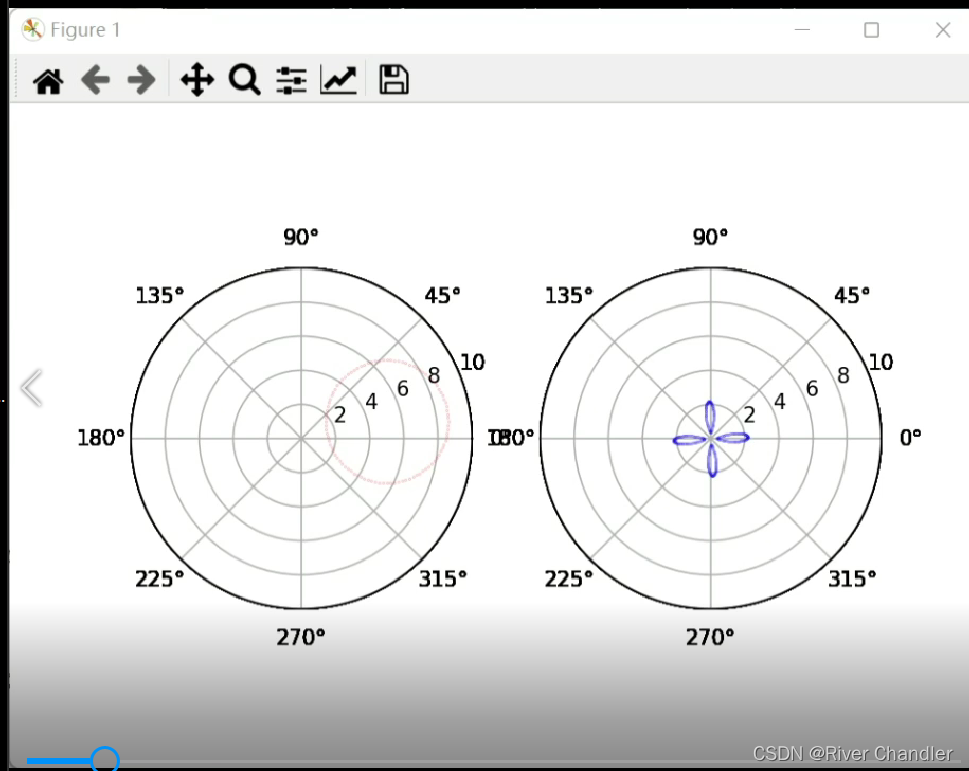- 好习惯,讲问题先上效果图

你问博主为什么不把它整成一个动画,简单,博主不会
- 好习惯二 讲问题先上全部代码
#复变函数的可视化 根式函数的可视化
import matplotlib.pyplot as plt
from matplotlib.animation import ArtistAnimation
import numpy as np
import multiprocessing as mp
#tip1:Github 上有很好的例子
#tip2:Python 中是有complex()这个函数的
#tip3:正经人谁搞个复数还要面向对象......
#tip4:数理方法,笑死,根本不懂
#tip5:复变函数是复平面到复平面的对应
#如果你想实现如实变函数一样的效果 什么(z-z**2)**1.5+z*(z*0.5)
#可能略有难度...
class complex_number():
def __init__(self,Mod,Arg):
self.Mod = Mod
self.Arg = Arg
def fun(R,steps=100):
global start
d_theta = 2*np.pi/steps
this_list = []
for step in range(steps):
theta = step * d_theta
x,y = start[0]+R*np.cos(theta),start[1]+R*np.sin(theta)
r = (x**2+y**2)**0.5
t = np.arctan(y/x)
if x<0:
t = t + np.pi
this_list.append(complex_number(r,t))
ax1 = fig.add_subplot(1,2,1,projection="polar")
ax1.set_ylim([0,10])
for i in this_list:
plt.polar(i.Arg,i.Mod,"ro",ms=0.1)
return this_list
def Shine(this_list,k=2):
shine_dict = {} #shine 表示映射
for i in range(k): #为什么是k呢,根式函数开几次方就几个branch 你要问1.5次方呢?综值的问题吧
shine_dict[i] = [] #这叫做提前分配内存 虽然我们不太可呢遇上什么 开50000次方的问题
shine_dict["Mod_list"] = [] #但这是好习惯
ax2 = fig.add_subplot(1,2,2,projection="polar")
ax2.set_ylim([0,10])
for this in this_list:
args = [this.Arg/k+i*2*np.pi/k for i in range(k)]
shine_dict["Mod_list"].append(this.Mod/k)
shine_dict[this_list.index(this)] = args
for ARG in args:
plt.polar(ARG,this.Mod/k,"bo",ms=0.1)
if __name__ == "__main__":
frames = []
start = [5,1]
R_range = [0.1,0.7]
R_step = 0.2
fig = plt.figure()
for i in range(100):
Shine(fun(0.2+i*R_step),4)
plt.pause(0.1)
- 好习惯三
打开评论区,wait,wait,wait
- 简单介绍一下怎么操作
-
start = []- 这是在直角坐标系下的复数坐标 start = [1,2]表示 1+2i
- R_step 每次半径的增加量
- Shine(*,k=n) 表示开方的次数为n 仅支持正整数
- pause 表示图片暂停时间
- 这个不方便保持动画(博主不会)
- 数学机理
- 啊,博主不会
- 结束








 该博客介绍了如何使用Python进行复变函数的可视化,特别是根式函数的动态展示。作者通过创建一个`complex_number`类来表示复数,并提供了一个`fun`函数用于绘制复数轨迹。`Shine`函数则实现了根式函数的分支映射。博客还展示了如何用matplotlib创建动画效果,尽管作者提到自己不擅长此领域。代码示例中,`start`变量定义了复数起点,`R_step`控制半径增加量,而`Shine`函数的参数`k`决定了开方的次数。
该博客介绍了如何使用Python进行复变函数的可视化,特别是根式函数的动态展示。作者通过创建一个`complex_number`类来表示复数,并提供了一个`fun`函数用于绘制复数轨迹。`Shine`函数则实现了根式函数的分支映射。博客还展示了如何用matplotlib创建动画效果,尽管作者提到自己不擅长此领域。代码示例中,`start`变量定义了复数起点,`R_step`控制半径增加量,而`Shine`函数的参数`k`决定了开方的次数。


















 被折叠的 条评论
为什么被折叠?
被折叠的 条评论
为什么被折叠?










